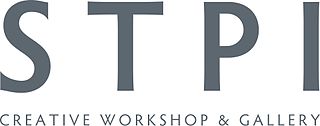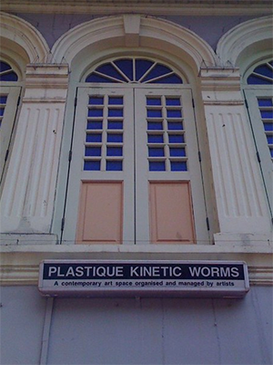Related Research Articles
LGBT art in Singapore, or queer art in Singapore, broadly refers to modern and contemporary visual art practices that draw on lesbian, gay, bisexual, and transgender+ imagery and themes, addressing topics such as LGBT rights, history and culture in Singapore. Such queer art practices are often by Singaporean or Singapore-based visual artists and curators who identify as LGBT+ or queer.
The Institute of Contemporary Arts (ICA) Singapore is the curatorial division of LASALLE College of the Arts, dedicated to supporting innovative and emerging creative practices. Focusing on art and design from the present, it provides an active site for contemporary culture in Singapore. It comprises five galleries that span a total of 1,500 square metres, one of the largest spaces devoted to contemporary art in Singapore. It engages local and international audiences in critical viewing and discussion through a diverse programme of exhibitions, projects, publications and events.

The Singapore Art Museum is an art museum is located in the Downtown Core district of Singapore. It is the first fully dedicated contemporary visual arts museum in Singapore with one of the world’s most important public collections by local, Southeast and East Asian artists. It collaborates with international art museums to co-curate contemporary art exhibitions.

The National Arts Council (NAC) is a statutory board established on 15 October 1991 to oversee the development of arts in Singapore. It is under the purview of the Ministry of Culture, Community and Youth. The NAC provides grants, scholarships, awards and platforms for arts practitioners, as well as arts education and programmes for the general public.

The Singapore Biennale is a large-scale biennial contemporary art exhibition in Singapore, serving as the country’s major platform for international dialogue in contemporary art. It seeks to present and reflect the vigour of artistic practices in Singapore and Southeast Asia within a global context, fostering collaboration and engagement between artists, arts organisations, and the international arts community.

The culture of Singapore has changed greatly over the millennia. Its contemporary modern culture consists of a combination of Asian and European cultures, mainly by Malay, South Asian, East Asian and Eurasian influences. Singapore has been dubbed as a country where "East meets West", "Gateway to Asia" and a "Garden city".

The Artists Village (TAV) is a Singapore-based contemporary art group. It is known as Singapore's first art colony, founded by contemporary artist Tang Da Wu in 1988.
Gajah Gallery is an art gallery in Singapore that hosts artwork related to the socio-cultural interests of Asia. It was established in 1995 by Jasdeep Sandhu and promotes Southeast Asian Contemporary Art with an emphasis on Indonesian Contemporary. The gallery holds exhibitions, some of which have been collaborations with the Singapore Art Museum (SAM) and the National University of Singapore Museum (NUS). Gajah Gallery is also a member of Art Galleries Association in Singapore.
June Yap is a Singaporean curator, art critic, and writer. She is currently the Director of Curatorial & Collections at the Singapore Art Museum.

STPI - Creative Workshop & Gallery, Singapore is a creative workshop and contemporary art gallery based in Singapore that specialises in artistic experimentation in the medium of print and paper. To date, STPI has collaborated with over 90 artists from all over the world.

The art produced in Southeast Asia includes the art from eleven countries that form Southeast Asia. The cultural development of the area was historically dominated by Indian influence, though several cohesive traits exist before Indian influence. The art is inspired by many countries.

The 5th Passage Artists Limited, commonly known as 5th Passage or 5th Passage Artists, was an artist-run initiative and contemporary art space in Singapore from 1991 to 1994. As a registered, artist-led non-profit organisation, it was one of the earliest of its kind for early-1990s Singapore, with its initial space located at Parkway Parade, a shopping centre in the east of the city. The "meteoric existence" of 5th Passage has been noted alongside other art collectives and alternative spaces existing in 1990s Singapore, such as The Artists Village, The Substation, Plastique Kinetic Worms, and Trimurti.

Juliana Yasin was a Singaporean contemporary artist and curator whose practice spanned painting, installation, video, and performance art. Her works examined notions of identity, subjectivity, and community practices. Pedagogy and research further complemented her artistic practice, with Juliana having taught fine art at Kolej Bandar Utama in Kuala Lumpur and worked as a Singapore-based researcher for the Asia Art Archive, Hong Kong.

Suzann Victor is a Singaporean contemporary artist based in Australia whose practice spans installation, painting, and performance art. Victor is most known for her public artworks and installations that examine ideas of disembodiment, the postcolonial, and the environmental in response to space, context and architecture.

Plastique Kinetic Worms (PKW) was a Singapore-based artist-run space and contemporary art collective, co-founded in 1998 by Singaporean artists Vincent Leow and Yvonne Lee. PKW was one of the few artist-run spaces in Singapore when it opened in the late 1990s, with the 1990 closure of the Ulu Sembawang site of Singapore's first artist colony, The Artists Village, and the disbanding of artist-run space and initiative, 5th Passage, after 1994. Originally organised around a collective of 10 artists, PKW's membership would vary, with around 15 to 20 members at various points of its active years.
Salleh Japar is a Singaporean contemporary artist working across sculpture, installation and painting, with his work coming into prominence in late 1980s Singapore. Within Singapore's history of contemporary art, Salleh is known for his collective work with Goh Ee Choo and S. Chandrasekaran for the seminal 1988 exhibition, Trimurti. In 2001, Salleh was one of four artists selected to represent at the very first Singapore Pavilion at the prestigious 49th Venice Biennale, alongside artists Henri Chen KeZhan, Suzann Victor, and Matthew Ngui.
Titarubi is an Indonesian artist. She is based in Yogyakarta and is one of Indonesia's most prominent contemporary artists.
Thiagarajan Kanaga Sabapathy, better known as T.K. Sabapathy, is a Singaporean art historian, curator, and critic. Sabapathy has written, researched, documented, and supported contemporary visual art in Singapore and Malaysia for four decades. He has held positions at the National University of Singapore, Nanyang Technological Institution, and National Institute of Education as a lecturer of art history. Sabapathy further established and headed pioneering art research facilities in Singapore, such as the Contemporary Asian Art Centre (2001–2004) and subsequently, Asia Contemporary (2015–).

The visual art of Singapore, or Singaporean art, refers to all forms of visual art in or associated with Singapore throughout its history and towards the present-day. The history of Singaporean art includes the indigenous artistic traditions of the Malay Archipelago and the diverse visual practices of itinerant artists and migrants from China, the Indian subcontinent, and Europe.
References
- 1 2 Huang, Lijie (1 December 2015). "Wahyuni Hadi and Dr Susie Lingham talk women, power and culture". The Straits Times. Archived from the original on 28 June 2020. Retrieved 28 June 2020.
- 1 2 3 4 Lum, Chee-Hoo (2013). Contextualized Practices in Arts Education: An International Dialogue on Singapore. Singapore: Springer. pp. xxxii. ISBN 978-981-10-1165-8.
- 1 2 3 4 5 6 7 8 Huang, Lijie (20 January 2014). "A heart for the arts" (PDF). The Straits Times. Archived (PDF) from the original on 28 July 2020. Retrieved 28 July 2020.
- 1 2 3 4 5 6 "Dr. Susie Lingham". Nanyang Academy of Fine Arts. 2014. Archived from the original on 28 July 2020. Retrieved 28 July 2020.
- 1 2 3 Legaspi-Ramirez, Eileen (March 2019). "Art on the Back Burner: Gender as the Elephant in the Room of Southeast Asian Art Histories". Southeast of Now: Directions in Contemporary and Modern Art in Asia. 3 (1): 25–48. doi: 10.1353/sen.2019.0002 . S2CID 166232952 . Retrieved 8 June 2020.
- 1 2 Martin, Mayo (3 July 2013). "New director for SAM". No. 2. TODAY. p. 52. Retrieved 9 June 2020.
- 1 2 Huang, Lijie (19 December 2015). "Susie Lingham to leave SAM". The Straits Times. Archived from the original on 9 June 2020. Retrieved 9 June 2020.
- ↑ Lingham, Susie (2021). "A Larger Reality" (PDF). Cultural Connections. 6: 120.
- ↑ Nurjuwita, Dewi (28 August 2018). "Q&A: Suzann Victor on paving her way as a female Singaporean artist in the 1980s". Lifestyle Asia. Archived from the original on 9 June 2020. Retrieved 9 June 2020.
- 1 2 Huang, Lijie (28 July 2014). "Artist Suzann Victor keeps pushing boundaries to connect with the public through art". The Straits Times. Archived from the original on 8 June 2020. Retrieved 8 June 2020.
- 1 2 3 Lee, Weng Choy (1996). "Chronology of a Controversy". In Krishnan, S.K. Sanjay; Lee, Weng Choy; Perera, Leon; Yap, Jimmy (eds.). Looking at Culture. Singapore: Artres Design & Communications. ISBN 9810067143. Archived from the original on 8 June 2020.
- 1 2 Peterson, William (2001). "Queering the Stage". Theatre and the Politics of Culture in Contemporary Singapore. Middletown, CT: Wesleyan University Press. pp. 154–155. ISBN 0819564710.
- ↑ Lingham, Susie (November 2011). "Art and Censorship in Singapore: Catch 22?". ArtAsiaPacific (76). Archived from the original on 8 June 2020. Retrieved 8 June 2020.
- ↑ Yap, June (2016). Singapore: Censorship, Institutions, and Alternatives (Technical report). p. 14. doi:10.13140/RG.2.2.11965.05603.
- ↑ "How to construct a valve on intensity?". The Necessary Stage. 2001. Archived from the original on 28 July 2020. Retrieved 22 October 2020.
- ↑ Lyon, Matthew (12 July 2001). "[names changed to protect the innocent]: sex valve durmientes by the necessary stage". The Flying Ink Pot Theatre Reviews. Archived from the original on 22 October 2020. Retrieved 22 October 2020.
- 1 2 3 Chng, Nai Wee. "Susie Lingham". Biotechnics (Singapore Art Archive). Archived from the original on 26 June 2020. Retrieved 28 July 2020.
- 1 2 Pocock, Melanie (2013). "The Artist, the Book and the Crowd". ArtAsiaPacific. Archived from the original on 10 August 2020. Retrieved 28 July 2020.
- 1 2 3 4 5 Martin, Mayo (18 January 2013). "Susie Lingham's Turn and the delicate act of looking inward". TODAY. Archived from the original on 28 July 2020. Retrieved 28 July 2020.
- ↑ "Susie Lingham". Gajah Gallery. Retrieved 7 May 2023.
{{cite web}}: CS1 maint: url-status (link) - 1 2 "5th Passage: In Search of Lost Time". Gajah Gallery. 2021. Retrieved 13 July 2022.
{{cite web}}: CS1 maint: url-status (link) - 1 2 Chia, Adeline (9 November 2021). "5th Passage: In Search of Lost Time". ArtReview. Archived from the original on 18 July 2022. Retrieved 13 July 2022.
- ↑ "Thought Sample Return". Gajah Gallery. 2022. Retrieved 7 May 2023.
{{cite web}}: CS1 maint: url-status (link)